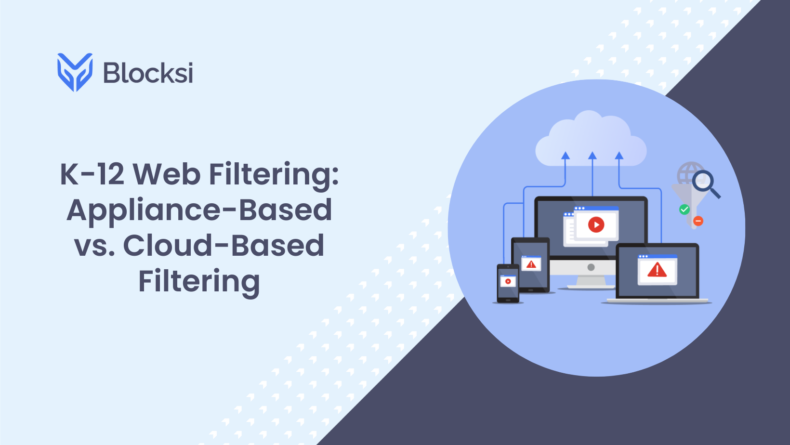NEWS
K-12 Web Filtering: Appliance-Based vs. Cloud-Based Filtering

In the realm of K-12 web filtering, schools face the critical decision of selecting the most suitable method to regulate online content access. This choice significantly impacts students’ safety, educational integrity, and overall network efficiency. As technology continues to evolve, two primary approaches have emerged: appliance-based and cloud-based filtering systems.
Understanding Appliance-Based Filtering
Appliance-based filtering involves hardware devices installed within the school’s network infrastructure to monitor and restrict internet access. These physical appliances analyze web traffic in real-time, applying predefined rules and policies to block or allow specific content categories. While this method offers some level of control, it presents inherent limitations and challenges.
One major drawback of appliance-based filtering is its susceptibility to hardware failures and maintenance issues. As these devices age, they may become prone to malfunctions, resulting in downtime and disruptions to internet services. Additionally, appliance-based solutions often require manual updates and configuration, demanding significant time and resources from IT personnel.

Challenges with Appliance-Based Filtering
Another concern with appliance-based filtering is its limited scalability and flexibility. Schools experiencing growth or changes in their IT infrastructure may struggle to adapt their filtering systems accordingly. Expanding the capacity of hardware appliances or integrating them with new technologies can be cumbersome and costly, hindering the school’s ability to meet evolving demands.
Moreover, appliance-based filtering typically lacks the granular control and real-time insights provided by cloud-based solutions. Administrators may find it challenging to customize filtering policies or track internet usage patterns effectively. This limitation compromises the school’s ability to address emerging threats and enforce compliance with acceptable use policies.
Advantages of Cloud-Based Filtering
In contrast, cloud-based filtering offers a more robust, scalable, and dynamic approach to K-12 web filtering. By leveraging remote servers and advanced algorithms, cloud-based solutions deliver unparalleled reliability, efficiency, and security. These platforms analyze web traffic across multiple devices and locations, ensuring consistent protection and performance for all users.

One of the primary advantages of cloud-based filtering is its inherent flexibility and scalability. Unlike appliance-based solutions, which rely on physical hardware, cloud-based platforms can seamlessly adapt to changing network demands and user requirements. Additionally to the easy setup and deployment, cloud-based software takes no physical space and is the most flexible. Schools can easily adjust filtering policies, add or remove features, and scale resources as needed without hardware limitations.
Why a Cloud-Based Web Filter for Schools Reigns Supreme
Cloud-based filtering also excels in terms of reliability and uptime. By distributing filtering capabilities across redundant servers and data centers, these solutions minimize the risk of single points of failure and ensure uninterrupted internet access for students and staff. Additionally, cloud-based platforms often incorporate advanced threat intelligence and machine learning algorithms to identify and block malicious content in real time proactively.
These are 5 reasons K-12 threat detection is crucial for any modern school.
Another compelling benefit of cloud-based school web filtering is its simplified management and maintenance. With centralized administration portals and automated updates, IT administrators can efficiently monitor and control filtering policies from anywhere with an internet connection. This streamlined approach reduces the burden on IT staff and allows schools to focus on their core educational mission.
In case you are wondering how to block YouTube, rest assured because (along with more than 85 web filtering categories) Blocksi also backs filtering across 30 YouTube categories, including filtering access to YouTube Shorts.

Choosing the Right Filtering Solution
When selecting a web filter for schools, it’s essential to consider your educational institution’s unique needs and challenges. While appliance-based solutions may offer some level of control, they often fall short in terms of scalability, reliability, and flexibility. In contrast, cloud-based filtering provides a comprehensive and future-proof approach to K-12 web filtering, empowering schools to protect students’ online experiences while maximizing network performance.
Aim for K-12 Web Filtering to Back Your School Security With Highest Accuracy
Amidst the multitude of cloud-based filtering solutions, Blocksi stands out as a top choice for schools seeking bulletproof filtering capabilities, unlimited bandwidth, and seamless integration. With a robust 99.99% service uptime and advanced cluster technology, you can be ensured of uninterrupted internet access and optimal network performance for your institution.
These are some signs your school web filter may be too restrictive.
Furthermore, its flexible scheduling features allow schools to extend filtering beyond school hours, providing added peace of mind for parents and administrators alike. In conclusion, the shift towards cloud-based filtering represents a significant step forward for K-12 web filtering, offering unparalleled reliability, safety, and efficiency. By embracing cloud-based solutions like Blocksi, schools can create a secure and productive online environment for students while simplifying IT management and reducing costs in the long run.
Choose Content Filtering Fit for Your School
Reach out to us today and join thousands of schools across the globe using our cloud-based content filtering. AI blur of adult images and video, advanced user-applied policies, and time-based penalty boxes are only a few of the features we give to schools of the 21st century.
SOURCES
[1] Web filtering in schools
[2] Tips for Surviving Your First Year as a School Administrator





